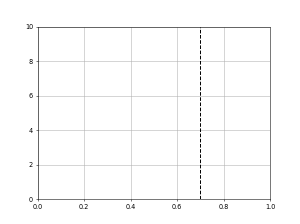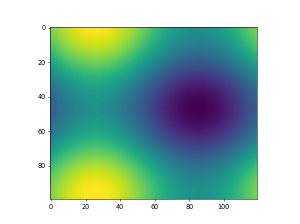W3cubDocs
/Matplotlib 3.5matplotlib.pyplot.subplots
- matplotlib.pyplot.subplots(nrows=1, ncols=1, *, sharex=False, sharey=False, squeeze=True, subplot_kw=None, gridspec_kw=None, **fig_kw)[source]
-
Create a figure and a set of subplots.
This utility wrapper makes it convenient to create common layouts of subplots, including the enclosing figure object, in a single call.
- Parameters
-
- nrows, ncolsint, default: 1
-
Number of rows/columns of the subplot grid.
- sharex, shareybool or {'none', 'all', 'row', 'col'}, default: False
-
Controls sharing of properties among x (sharex) or y (sharey) axes:
- True or 'all': x- or y-axis will be shared among all subplots.
- False or 'none': each subplot x- or y-axis will be independent.
- 'row': each subplot row will share an x- or y-axis.
- 'col': each subplot column will share an x- or y-axis.
When subplots have a shared x-axis along a column, only the x tick labels of the bottom subplot are created. Similarly, when subplots have a shared y-axis along a row, only the y tick labels of the first column subplot are created. To later turn other subplots' ticklabels on, use
tick_params.When subplots have a shared axis that has units, calling
set_unitswill update each axis with the new units. - squeezebool, default: True
-
-
If True, extra dimensions are squeezed out from the returned array of
Axes:- if only one subplot is constructed (nrows=ncols=1), the resulting single Axes object is returned as a scalar.
- for Nx1 or 1xM subplots, the returned object is a 1D numpy object array of Axes objects.
- for NxM, subplots with N>1 and M>1 are returned as a 2D array.
- If False, no squeezing at all is done: the returned Axes object is always a 2D array containing Axes instances, even if it ends up being 1x1.
-
- subplot_kwdict, optional
-
Dict with keywords passed to the
add_subplotcall used to create each subplot. - gridspec_kwdict, optional
-
Dict with keywords passed to the
GridSpecconstructor used to create the grid the subplots are placed on. - **fig_kw
-
All additional keyword arguments are passed to the
pyplot.figurecall.
- Returns
-
-
fig
Figure -
ax
axes.Axesor array of Axes -
ax can be either a single
Axesobject or an array of Axes objects if more than one subplot was created. The dimensions of the resulting array can be controlled with the squeeze keyword, see above.Typical idioms for handling the return value are:
# using the variable ax for single a Axes fig, ax = plt.subplots() # using the variable axs for multiple Axes fig, axs = plt.subplots(2, 2) # using tuple unpacking for multiple Axes fig, (ax1, ax2) = plt.subplots(1, 2) fig, ((ax1, ax2), (ax3, ax4)) = plt.subplots(2, 2)
The names
axand pluralizedaxsare preferred overaxesbecause for the latter it's not clear if it refers to a singleAxesinstance or a collection of these.
-
fig
Examples
# First create some toy data: x = np.linspace(0, 2*np.pi, 400) y = np.sin(x**2) # Create just a figure and only one subplot fig, ax = plt.subplots() ax.plot(x, y) ax.set_title('Simple plot') # Create two subplots and unpack the output array immediately f, (ax1, ax2) = plt.subplots(1, 2, sharey=True) ax1.plot(x, y) ax1.set_title('Sharing Y axis') ax2.scatter(x, y) # Create four polar axes and access them through the returned array fig, axs = plt.subplots(2, 2, subplot_kw=dict(projection="polar")) axs[0, 0].plot(x, y) axs[1, 1].scatter(x, y) # Share a X axis with each column of subplots plt.subplots(2, 2, sharex='col') # Share a Y axis with each row of subplots plt.subplots(2, 2, sharey='row') # Share both X and Y axes with all subplots plt.subplots(2, 2, sharex='all', sharey='all') # Note that this is the same as plt.subplots(2, 2, sharex=True, sharey=True) # Create figure number 10 with a single subplot # and clears it if it already exists. fig, ax = plt.subplots(num=10, clear=True)
Examples using matplotlib.pyplot.subplots
© 2012–2021 Matplotlib Development Team. All rights reserved.
Licensed under the Matplotlib License Agreement.
https://matplotlib.org/3.5.1/api/_as_gen/matplotlib.pyplot.subplots.html

